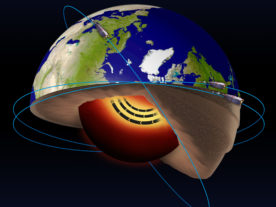New Record for Biggest Wave Measured by Buoy
The UN’s World Meteorological Society says the biggest wave ever to be measured by a buoy was identified at 0600 universal time on February 4, 2013.
The colossal 19-meter swell was spotted in the North Atlantic Ocean between Iceland and the UK.
The previous highest wave recorded by a buoy was measured at over 18 meters, on December 8, 2007, also in the North Atlantic.
The WMO says that the buoy that recorded the giant wave is a part of the UK’s Met Office (the British weather service) network of Marine Automatic Weather Stations.
Wave-measuring buoys are part of an extensive international observational network, which also includes ships and satellite observations to keep an eye on the oceans and make forecasts for weather-related hazards.
While this wave was the highest measured by a buoy, it’s certainly not the biggest overall — a nearly 31-meter high wave in Alaska, generated by an earthquake, is in the record books from 1958.

Walking feet (Pete Stanton/Creative Commons via Flickr)
Why Do Humans Walk Heel-to-Toe?
University of Arizona doctoral student James Webber loves to run in his bare feet. It was his inspiration to study the mechanics of running.
But since it’s said you’ve got to walk before you run, Webber has focused his recent research on walking.
He incorporates his research into a new study that explores why humans walk heel-to-toe, while a number of other animal species walk on the balls of their feet.
Webber’s study suggests a human’s walk boils down to the length of our legs.
He explains that since we stand with heels down on the ground, our legs are physically shorter that if we stood on our toes.
To become more efficient walkers, Webber posits that we’ve had to adopt a heal-to-toe style of walking that produces what he calls “virtual legs” that are longer than actual physical legs.

A view of Earth’s atmosphere at sunset as seen by the International Space Station Expedition 23 crew in 2010. Colors here roughly denote the various layers of the atmosphere. (NASA)
Harvard Researchers Have Idea to Safely Cool Planet
A recent assessment by the UN’s World Meteorological Organization indicates that 2016 will likely be the hottest year on record.
Some scientists have suggested that injecting light-reflecting sulfate aerosols into the stratosphere might cool the planet.
The problem with this approach is that while sulfate aerosols could cool the world, a nasty side effect would be that doing so would produce sulfuric acid in the atmosphere.
This is something scientists say would damage the ozone layer, which in itself could lead to a variety of health problems for Earth’s living creatures.
Now, Harvard researchers say that they found using calcite, a component of limestone, rather than sulfates in an aerosol might be able to cool the planet while at the same time repair any ozone damage. But both ideas reside only in the halls of academia, for now – no such global climate control plans are actually underway.

ALMA image of the protoplanetary disk surrounding the young star HD 163296 as seen in dust. (ALMA-ESO/NAOJ/NRAO/AUI/NSF)
Signs of Developing Planets Orbiting Young Star
Most of the extrasolar planets discovered so far are orbiting older or more mature stars with a fully developed planetary system.
But, new observations made by scientists working with the Atacama Large Millimeter/submillimeter Array (ALMA) in Chile are providing evidence of two, still developing, possibly Saturn-sized planets circling a relatively young star called HD 163296.
The scientists say signs of the two developing planets were found in rings of carbon monoxide gas between bands of dust within the star’s surrounding protoplanetary disk, or materials left over from the formation of the star.
The planet’s host star is said to be located some 400 light-years from Earth, is only about 5 million years old, and has about twice the mass of our Sun.
Astronomers find that these two newborn planets are forming at distances from its sun that would be equivalent to being well beyond our solar system’s Kuiper Belt – that’s the region space beyond the orbit of Neptune.























Comments are closed.